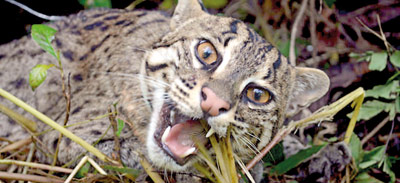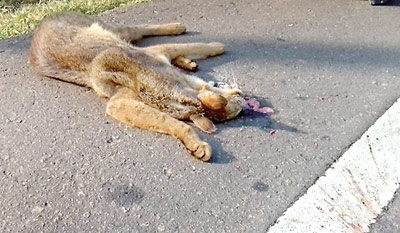News
Wildcats in the shadow of the leopard also vanishing

In pain: A Fishing Cat caught in a wire trap and rescued by young researcher Ashan Thudugala
The death of a full-grown jungle cat at the hands of a speeding motorist late last month highlights the worrying fate of these animals while public concerns focus on fatalities of their more magnificent cousin, the leopard.
Photographs of the dead jungle cat lying stretched across a road near Wilpattu were published on social media by a saddened local motorist, Saranga Dissanayake who said he had also seen a fishing cat killed on the same stretch a few months ago.
Sri Lanka is home to four species of wildcat: leopard (Panthera pardus – kotiya diviya), fishing cat (Prionailurus viverrinus – handun diviya), jungle cat (Felis chaus – wal balala) and rusty-spotted Cat (Prionailurus rubiginosus – Kola diviya).
The killing of a leopard last August on a road in Yala sparked much attention but other wildcats sharing the same plight mostly go unnoticed.
According to the International Union for the Conservation of Nature (IUCN) Red List of threatened species the jungle cat is “near threatened” while the other three species are “endangered” indicating the need of urgent action for their conservation.
Other than road accidents, Sri Lankan wildcats face death through wire traps, poisoning and habitat destruction.
Sadly, insufficient research exists to identify the level of these threats, the ecology of the individual species and species distribution, factors that are the basis of any conservation action.
The first Symposium of Wild Cats of South Asia, past and present, organised by the Sri Lanka Wildlife and Nature Protection Society (WNPS) with support from the Mohamed bin Zayed Species Conservation Fund and the IUCN last November provided a forum for Sri Lankan and foreign researchers to forge links and identify directions for wildcat research.

Jungle Cat killed near Wilpattu on January 22. Pic by Saranga Dissanayake
The researchers agreed knowledge was lacking on small cats compared to leopards, especially rusty-spotted cats and jungle cats.
WNPS President Professor Lakdas Fernando said a wildcat working group has now been established. “Understanding conservation priorities will be the first step toward saving these species.
Hopefully we can meet in two years for another symposium where we can take solid conservation action for Sri Lanka’s wildcats,” Professor Fernando said.
The November symposium was a good platform for many young researchers such as Anya Ratnayake who study wildcats.
Ms Ratnayake, who spearheads a fishing cat study project by the Environmental Foundation Limited, said she had found fishing cats living in areas adjacent to dense human habitation to be active at day and night. Researchers tracked individual fishing cats fitted with GPS collars.
“Based on the distribution and movement patterns of fishing cats in urban habitats we proposed the creation of urban bioparks for biodiversity conservation and green areas for urban wildlife,” the young researcher said, adding that integration of these zones was more important than ever with the proposed megapolis development plans across the Western Province.
Ashan Thudugala, a young researcher following fishing cats in the hill country, spoke out on threats posed by speeding motorists to these cats, as well as poaching and poisoning.
It is heartening to see that young researchers are going beyond paperwork to protect wildcat populations. Ashan Thudugala, for example, conducts awareness programs and youth camps for schoolchildren and local villagers in areas where wildcat mortality is high. Fishing cat roadsigns have been placed at danger spots on roads.
A leading authority, Dr. Jim Sanderson of the Small Wildcat Conservation Foundation, specially praised the work of the young researchers of Sri Lanka in studying smaller wildcats.
The conservation of leopards is still a key focus. In recently released symposium papers, researchers Andrew Kittle and Anjali Watson explain that the change of land use patterns in many areas poses a threat to Sri Lanka’s apex predator.
Dr. Andrew Kittle particularly highlighted the threats faced by hill country leopards. “Ongoing distribution mapping indicates that leopards occupy small, isolated forest patches with little or no protection.
Many of these occur in Sri Lanka’s central highlands where a high human population density, heavily-fragmented landscape mosaic and lack of large, contiguous protected areas means leopards here are potentially highly vulnerable,” he states.

